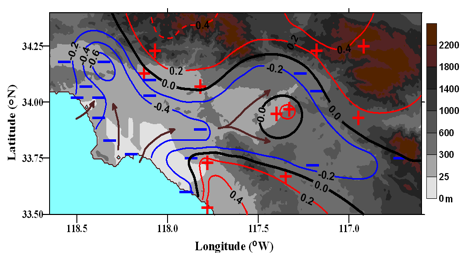CALIFORNIA RESEARCH
Coastal Cooling Research
Observational Study
Analyses were carried out of observational climatological (1970-2004) California summer temperatures from 253 NWS Coop sites in two air basin regions: South Coast Air Basin (SCoAB) and San Francisco Bay Area (SFB). Results for all California 253 COOP sites together showed increased (-0.23oC decade−1) Tave-values); asymmetric warming, as Tmin-values increase faster than Tmax-values (0.27 vs. 0.04oC decade−1); and thus decreased DTR values (0.15oC decade−1). The spatial distribution of observed SoCAB and SFBA Tmax-values exhibited a complex pattern, with cooling (-0.30oC decade−1) in low-elevation coastal-areas open to marine air penetration and warming (0.32oC decade−1) at inland areas. While summertime nighttime min temperatures showed expected greenhouse-gas induced warming, corresponding daytime max values showed concurrent warming in inland areas and cooling in coastal areas influenced by marine air penetration. This suggests that the inland warming resulted in increased coastal sea-breeze activity.
Spatial distribution of trends in SoCAB 2-m summertime maximum-temperatures (oC dec- ade-1) for 1970-2005; arrows indicate predominant summertime flow-patterns, pluses/minuses (+/-) warming/cooling stations, and isopleths follows: blue/red for cooling/warming areas, red dashed for extrapolated warming areas, and black for zero-change.
Modeling Study
Further investigation using mesoscale model simulation, using the Regional Atmospheric Modeling System (RAMS), with a horizontal grid resolution of 4 km on an innermost grid over SoCAB are undertaken to investigate the effect of the long-term changes of green house gas and land use land cover on the coastal flow. Results show that comparison of present and past climate conditions reflect significant increase in sea breeze and coastal cooling, which supports the hypothesis that coastal cooling is a possible direct result of green house gas warming, while the effect of urbanization on coastal environment is twofold; mechanical properties deter the sea breeze flows and thermal aspect enhances the sea breeze. Significant societal impacts may result from this observed reverse-reaction to GHG-warming. Possible beneficial effects (especially during periods of UHI growth) include decreased maximum: O3 levels, per-capita energy requirements for cooling, and human thermal-stress levels.
Such coastal cooling will impact summer daytime fossil-fuel energy consumption, ozone levels, water supply, agricultural production, and human thermal-stress levels. These results could be useful in studies of similar “reverse-reaction” effects in other world wide coastal regions.

